May 4, 2001: An introduction to organic farming |
|
 |
We have a beautiful day today. The "large-scale consecutive holidays" this year, we have had many rainy days until yesterday. Today, it stopped raining and cool breeze blows as if it urges me to washing and cleaning house. After the washing in the morning, we made up our minds to take a walk for health. Carp streams are swinging in the sky, yes, tomorrow is Children's Day. |
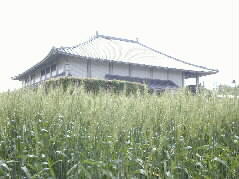 |
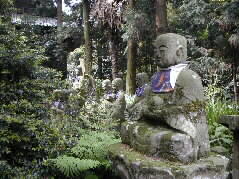 |
| Across the green wave of wheat is the large roof of Municipal Historical Museum shining in the sky. The area is the ruin of Bungo Kokubuji in old days. On the back of the Museum, thick forest offers cooling shade to many lovely stone images of Jizou (a guardian deity of children.) | |
| Passing through Bungo Kokubu railroad station, we continued walking. After a while, we arrived at a farm under a tall paulownia that holds many beautiful blue flowers. This is the private farm of Mr. Satoh, one of our close friends. He said a couple days ago that he would enjoy farming when it cleared up, but he is not here today. | 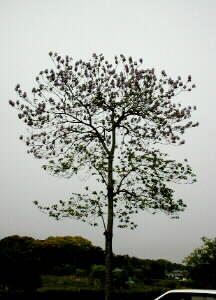 |
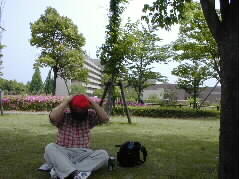 |
Well, we will visit him today. On our way
to his house we bought simple lunches in
a supermarket and took them under a shade
in Oita Medical College campus. The cool breeze arouses our appetites. |
| We saw Mr. Sato at his house and we drove
back to his farm with his car. Potato foliage
is shining in thick green. Satoh explained that he planted here three kinds of potatoes, May queen, Baron, and Andes. |
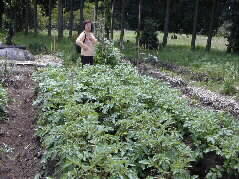 |
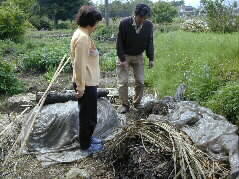 |
Mr. Sato borrowed this farm three years ago
and is now researching and practicing organic
agriculture besides his regular business. He shows me how to make real compost from died leaves and grasses. |
| He said me to touch the soil covered with vinyl sheet. I felt the heat of fermentation. | 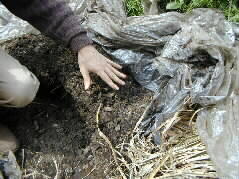 |
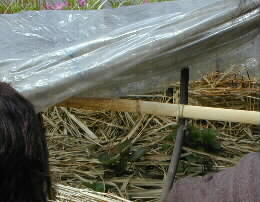 |
A straw-made green house covered with vinyl sheet on the top holds some seedlings of sweet potato. The seedlings will be transplanted to the field, he said. |
| Satoh took up a bottle he brought from home very carefully. This is a nutritious substance made from garlic, red pepper, Shochu liquor, dipped in wood vinegar. | 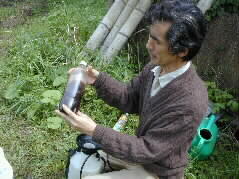 |
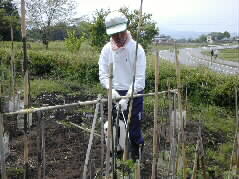 |
The liquid will be diluted to 500 times before spraying weakened seedlings. Mr. Nonaka, Satoh's farming friend, tries it on his plants. |
| Heaven gives the water for dilution. Rain water filled the drums under the eaves. |  |
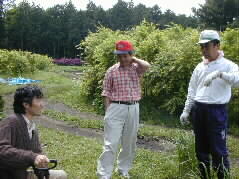 |
Satoh, sitting, and Mr. Nonaka, left, are
good friends each other in this Friendship
Farm. They teach and learn each other, they
said. Satoh want to send information on his practice through the web. We want, on the other hand, to learn about the organic farming. I took many pictures today. |
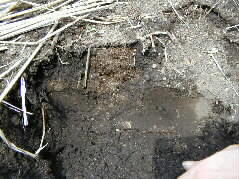 |
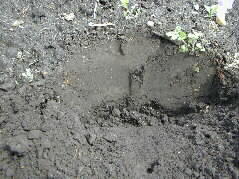 |
| Soil is the life of plant. There are many concepts on Organic farming, he said. He showed me three kinds of the cross-sections of the soil by cutting the field in three spots: On the left is the soil of plant-origin organic compost and on the right is the soil made from cattle droppings, and... | |
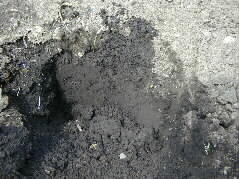 |
soil using chemical fertilizers. Clear differences
appear among them. The soil of plant-origin organic compost contains much air in each particle and soil is plump and soft in the mass. |
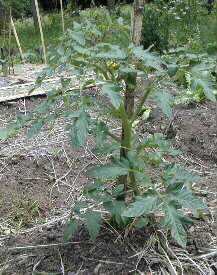 |
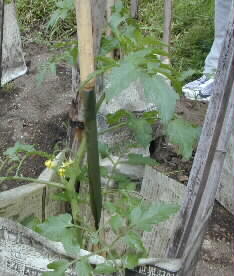 |
| Here is a comparison of the growth of tomato plant: on the left is the plant growing on the plant-origin compost soil (genuine) with its stout trunk and thick green foliage in deep green. On the right is one growing on the cattle dropping compost soil. | |
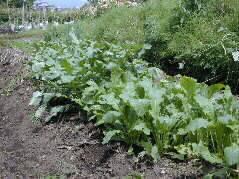 |
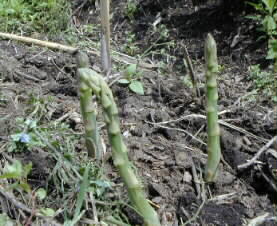 |
| Mr. Satoh presented us the other day wonderful turnip (left) and asparagus grown on the genuine soil. They were really sweet and tasty. | |
| Lovely "Lucky", Mr. Nonaka's dog said me good-bye after working together in the field today. He loves farming as well, Nakano smiled. |  |
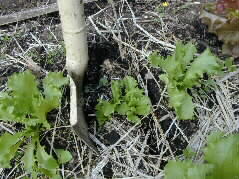 |
Field lecture by Satoh will soon be over. In the end, he shared me some seedlings of lettuce sprouted from the seeds. |
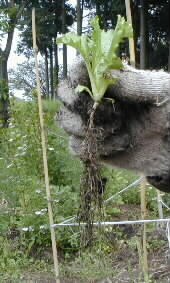 |
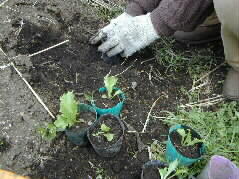 Watch the balance of the seedling and its root. The long root is a feature of real organic farming, he explained. The plant first stretches its root deep into the genuine soil, and then grows upward. The baby lettuce are carefully divided into the pots, not so as hurt their fragile roots. |
 Mt. Takasaki is visible faintly in the spring haze. Deep violet iris and pink azalea are at their best now. |
|
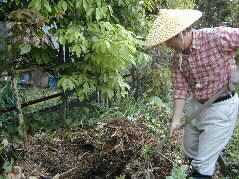 |
Mr. Satoh took us back home. Now the practice
starts. The first step is to make genuine compost from died leaves piled up in the corner of the kitchen garden. Under the guidance of Satoh, my husband works not reluctantly, I suppose, wearing working boots and a cap he was presented from our "virtual daughter" in the trip to Hong Kong last December. |
| In a corner of the kitchen garden, died leaves are piled up and flattened. Professor Satoh and my husband are already in sweat. | 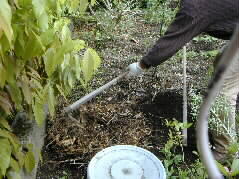 |
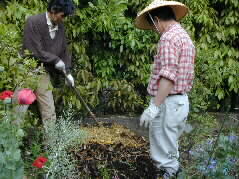 |
Kitchen garbage stored for a long time in a container is put on the leaves and... |
| spraying EM germ and... | 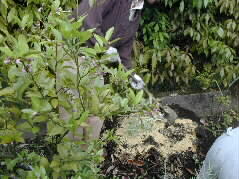 |
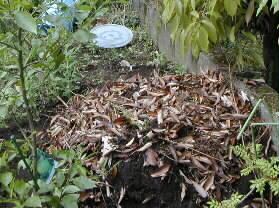 |
pile up the died leaves again and... |
| spraying the germ and water. Water is needed as well. | 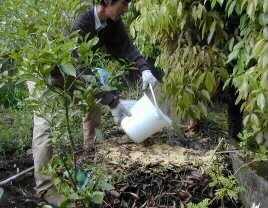 |
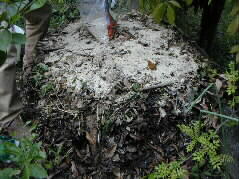 |
Fowl droppings, oilcake, and bone meal, almost forgotten in the container, are sprayed as well. |
| Charcoal powder is also useful in making genuine compost, the professor lectures. The powder is the remnants of barbecue charcoal. Quite a few amount of water is then sprayed again over the mound and pressed by foot. | 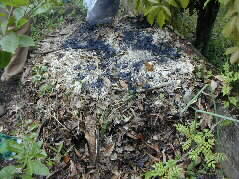 |
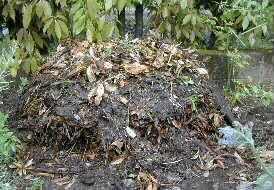 |
Finally, additional died leaves cover the
surface of the mound so as to avoid the direct
sunlight on the compost. A piece of vinyl
sheet is required to cover the top to accelerate
the fermentation, but as we don't have it
in home, today's work is over now. Occasional turn over of the mound is essential to feed oxygen. Good genuine organic compost will be made like this way and wonderful vegetables will be grown on it, Satoh said. |
Thank you very much, Mr. Satoh, your lecture
and practice on genuine organic compost making.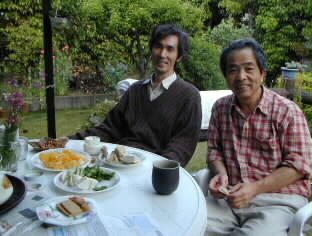 |
|
| Well, thank you very much for your efforts. Let's enjoy tea. Here are genuine turnip and lettuce taken just an hour ago from Satoh's field. Cream cheese and sour cream will be good for them, I hope. Enjoy yourself with homegrown orange and my homemade tea-bread I baked yesterday. After a hard work, the afternoon tea is really good! I am expecting what tasty genuine vegetables will grow in my kitchen garden. | |
May 5, 2001: Vinyl sheet cover |
|
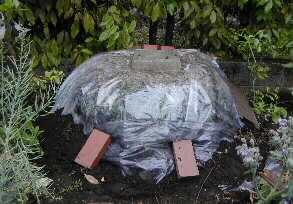 |
I am not sure why I was delighted very much
to see the mound we made yesterday. Today, we soon covered the mound with two pieces of vinyl sheet. We put a stone on the top to press the mound and shielded the skirt with soil and bricks. My delight increases. I visited the mound so frequently. The mound seems to generate fermenting heat from inside. |
June 18, 2001: Turning over the vegetable compost |
|
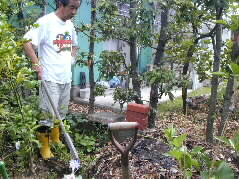 |
One and a half months have passed since we piled up the vegetable compost (died leaves based) in the kitchen garden.
Today, the compost will be turned over. |
|
The volume of the compost is decreased compared with the original size. The vinyl cover is removed and the mound is spread over the ground.
It means the compost is maturing in a good condition. |
 |
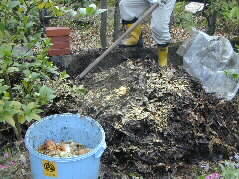 |
EM germ is scattered on the spread compost and kitchen garbage is put deep under it. |
| Let's mix well to feed abundant oxygen to the compost before piling up. | 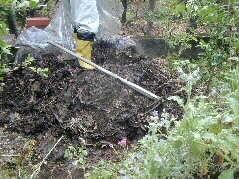 |
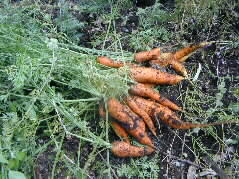 |
While my husband is working hard, I cropped the carrots.
I planted the seeds presented from my friend in my tiny kitchen garden. Here are great carrots like this. My original carrots feature their various sizes and shapes. The taste and smell were such like that reminds me dear old days. |
| The mound was again shaped up beautifully. It will be left as it is during the summer.
My husband looks happy to have completed the big job he has long been worrying about. |
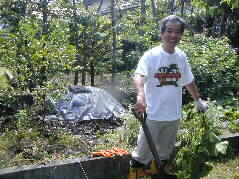 |
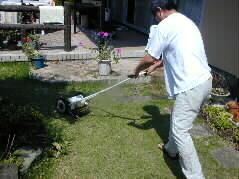 |
There is no reason to get sweat twice, he started mowing the lawn. The garden was cleaned well.
It will rain this evening, however. |